Senior Brand Manager
- FMA
- The Fabricator
- FABTECH
- Canadian Metalworking
Categories
- Additive Manufacturing
- Aluminum Welding
- Arc Welding
- Assembly and Joining
- Automation and Robotics
- Bending and Forming
- Consumables
- Cutting and Weld Prep
- Electric Vehicles
- En Español
- Finishing
- Hydroforming
- Laser Cutting
- Laser Welding
- Machining
- Manufacturing Software
- Materials Handling
- Metals/Materials
- Oxyfuel Cutting
- Plasma Cutting
- Power Tools
- Punching and Other Holemaking
- Roll Forming
- Safety
- Sawing
- Shearing
- Shop Management
- Testing and Measuring
- Tube and Pipe Fabrication
- Tube and Pipe Production
- Waterjet Cutting
Industry Directory
Webcasts
Podcasts
FAB 40
Advertise
Subscribe
Account Login
Search
The case for consumables
Simplified consumables help improve welding operations
- By Ross Fleischmann
- November 21, 2014
- Article
- Consumables

The average GMAW gun lasts six to 18 months in heavy-duty, high-cycle applications. New, simplified consumables like the threadless contact tip can help extend gun life.
The two most fundamental purposes of gas metal arc welding (GMAW) consumables are to transfer electricity to the wire and direct shielding gas so that it covers the weld pool. All consumables perform these functions but with vastly different levels of effectiveness, which manifests itself in ways such as contact tip life, arc stability, and weld quality.
Until there’s a problem, most of us take consumables for granted. Nonetheless, when you consider their most fundamental purposes, it’s clear that GMAW consumables contribute significantly to welding performance, uptime, and total cost of welding.
New-generation GMAW consumables can further improve these welding characteristics. A simplified design reduces the amount of components needed and optimizes electrical and thermal conductivity; as a result, they are more durable in spray and pulse transfer modes. They also allow for longer life. Further, spatter doesn’t adhere as easily, and shielding gas coverage is good even in windy conditions. New-generation GMAW consumables also feature gas ported contact tips that run cooler and last longer.
Out With the Old Technology, in With the New
In a GMAW gun with conventional consumables, a threaded copper contact tip screws into a brass or copper gas diffuser, which in turn screws onto the end of the conductor tube (see Figure 1). A slip-on nozzle mates with an insulating sleeve, and the welder eyeballs the contact tip/nozzle relationship. For the majority of GMAW guns, this basic design has remained unchanged for about half a century.
Today, however, GMAW consumables are beginning to receive the same design attention as power sources. Research shows that what welders dislike most about traditional threaded GMAW tips are the hassles associated with threads.
To start, when burnbacks occur, welders must use whelpers, pliers, or vise grips to unscrew a threaded tip. Large-diameter wires, 0.045 in. or bigger, offer significant resistance, and welders frequently lose their grip on the tip and need to start over. Putting the gun in a vise is a common solution. Threadless, drop-in-style contact tips eliminate altogether the need to perform this chore.
On these guns, a screw-on nozzle holds the contact tip in place and maintains a consistent flushness between the end of the contact tip and the end of the nozzle. When a burnback occurs, welders remove the nozzle, squeeze the gun trigger to advance the wire, and the tip pops out so the wire can be clipped (see Figure 2). Tip changes take a few seconds, not a minute of fighting against a large-diameter electrode.
Threads don’t just cause headaches for welders; each threaded connection is a chance for poor electrical conductivity, especially when threads get worn, are loose, or become damaged by spatter.
Conductivity is a measure of a material’s or system’s ability to carry electrical current. Any interference with the free flow of current increases resistance, and resistance in a circuit causes voltage to drop and heat to build up in the area where resistance occurs. What’s worse, increased heat further increases resistance. Common signs of poor conductivity and excessive resistance include an erratic arc, a need to increase voltage at the power source to compensate for voltage drop at the arc, more frequent burnbacks, and reduced consumables life.
All threadless contact tips improve conductivity in two ways. First, there are no threads that have the potential to come loose. Second, their wider base increases contact area for more positive current flow. However, until now these GMAW consumables still used a gas diffuser that screwed into the end of the conductor tube.

Figure 1
Conventional consumables (top) have
three sets of threaded connections in
the conductor path: the contact tip,
gas diffuser, and conductor tube end.
A new consumable design (bottom)
eliminates all threads from the conductor
path.
The newest generation of GMAW consumables eliminate the gas diffuser and seat directly into the end of the conductor tube (see Figure 3). With their threadless, all-copper conductor path, these consumables eliminate common sources of resistance, optimize electrical conductivity, and create a more stable arc.
Cooler Operation
Excess heat negatively affects electrical conductivity. As a result, an optimal GMAW consumable design would also improve thermal conductivity. Threadless tips inherently improve thermal conductivity because of their large contact area with the conductor tube, all-copper conductor path, and fewer connections in the system.
To further cool the contact tip, one style of medium- and heavy-duty contact tips has four gas ports machined into the base. Shielding gas flows from the conductor tube into the tip, then gets directed through four gas ports to flow outside the tip. This simplified design enables the shielding gas to cool the contact tip better.
Running cooler contributes to increased arc stability. It also reduces chatter, which is a stick-and-slip phenomena between the contact tip and the wire when both get very hot. Running cooler also means the copper in the contact tip remains harder, which prevents chatter. From an economic and productivity perspective, a harder surface wears more slowly, which in turn extends contact tip life.
No More “Mr. Tip”
At first DeMar Guymon, owner of Guymon Machining and Fabrication in Cleveland, Utah, had his doubts. But with as many consumables as his shop goes through, he was willing to try a ported contact tip.
“In the course of five months, we’ve gone through about a dozen contact tips on two guns, versus the 50 or 60 tips we used to go through,” Guymon said.
The company fabricates mining, power plant, and farming equipment, which means Guymon welds a variety of metals, including stainless steel, high-temperature alloys, high-tensile alloys, abrasion-resistant plates, and all types of mild steel. The shop extensively uses 0.045-in. and 1⁄16-in. dual-shield flux-cored wires.
“With the abrasion-resistant plates, the performance was great. I ran eight 44-lb. spools of hardfacing wire and never had a problem with the consumables.”
It wasn’t always this way.
“With eight guys out there welding using the old consumables, we would change a contact tip two or three times in an eight-hour shift. Now it’s more like once a week between the two guns,” Guymon added.
Sterling Cole, owner of Cole III Welding, Bakersfield, Calif., reports similar success. Cole began welding more than 30 years ago and today he employs seven to 14 year-round welders, serving customers primarily in the oil, food, and agricultural industries. In one particular application, he runs 0.045-in. gas-shielded flux-cored wire to join 3⁄16-in. plate to 27⁄8-in. oil field pipe, creating grape posts for vineyards. In this high-volume application, his welders average a 44-lb. spool of wire per day per machine.
“Previously I was buying from 50 to 75 standard tips a week for five welders. They used to call me ‘Mr. Tip’ down at the welding supply store. Now with the new [gas ported] consumables, we’re using about one tip per welder each week. Sometimes a single tip can last two weeks,” Cole said.
About the Author
Ross Fleischmann
16052 Swingley Ridge Road, Suite 300
St. Louis, MO 63017
800-426-1888
About the Publication
Related Companies
subscribe now

The Welder, formerly known as Practical Welding Today, is a showcase of the real people who make the products we use and work with every day. This magazine has served the welding community in North America well for more than 20 years.
start your free subscription- Stay connected from anywhere

Easily access valuable industry resources now with full access to the digital edition of The Fabricator.

Easily access valuable industry resources now with full access to the digital edition of The Welder.

Easily access valuable industry resources now with full access to the digital edition of The Tube and Pipe Journal.
- Podcasting
- Podcast:
- The Fabricator Podcast
- Published:
- 04/16/2024
- Running Time:
- 63:29
In this episode of The Fabricator Podcast, Caleb Chamberlain, co-founder and CEO of OSH Cut, discusses his company’s...
- Trending Articles
Sheffield Forgemasters makes global leap in welding technology

Welding student from Utah to represent the U.S. at WorldSkills 2024

Lincoln Electric announces executive appointments

Lincoln Electric acquires RedViking

Engine-driven welding machines include integrated air compressors

- Industry Events
16th Annual Safety Conference
- April 30 - May 1, 2024
- Elgin,
Pipe and Tube Conference
- May 21 - 22, 2024
- Omaha, NE
World-Class Roll Forming Workshop
- June 5 - 6, 2024
- Louisville, KY
Advanced Laser Application Workshop
- June 25 - 27, 2024
- Novi, MI



























